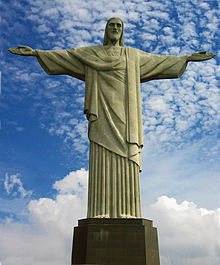Heitor da Silva Costa
Heitor da Silva Costa ( July 25, 1873 - April 21, 1947 ) was a Brazilian civil engineer .
Life
Heitor da Silva Costa, who was an atheist and, according to his great-granddaughter Maria Isabel Noronha, later converted to Christianity , was the winner of the competition for the erection of the monumental statue of Christ the Redeemer, which was announced three years earlier on the initiative of the Catholic Church Monumento Cristo Redentor on Corcovado in Rio de Janeiro .
The occasion for the competition was the 100th anniversary of Brazil's independence (1822).
The joint venture, financed by donations, was realized from 1926 according to the design from 1924 by da Silva Costa, who supervised the construction of the eight-meter-high base and the scaffolding for the 30-meter-high figure made of reinforced concrete. The plaster models, after which the head and hands were copied in concrete, were created by the French sculptor Paul Landowski (1875–1961) in his workshop in Boulogne-Billancourt near Paris , the surface was clad with a mosaic made of easily malleable soapstone Carlos Oswald .
With the Cristo Redentor , da Silva Costa created the largest Art Deco sculpture in the world. Its weight, including the base, is 1,145 tons. The construction of the Cristo Redentor on the 710 meter high Corcovado as well as the cladding presented enormous technical challenges and took five years to complete. The statue was inaugurated on October 12, 1931, the feast day of the patron saint of Brazil, Nossa Senhora da Conceição Aparecida , and has been a listed building since 1973.
Web links
- Christo Redentor turns 75 at Brazilfreunde.net
- Redeemer on the mountain top by Ole Schulz, Deutschlandradio Kultur
Footnotes
- ^ Maria Isabel Noronha: Cristo Redentor , documentary about the construction of the Christ the Redeemer sculpture
| personal data | |
|---|---|
| SURNAME | Silva Costa, Heitor there |
| ALTERNATIVE NAMES | Silva Costa, Heitor |
| BRIEF DESCRIPTION | Brazilian civil engineer |
| DATE OF BIRTH | July 25, 1873 |
| DATE OF DEATH | April 21, 1947 |
